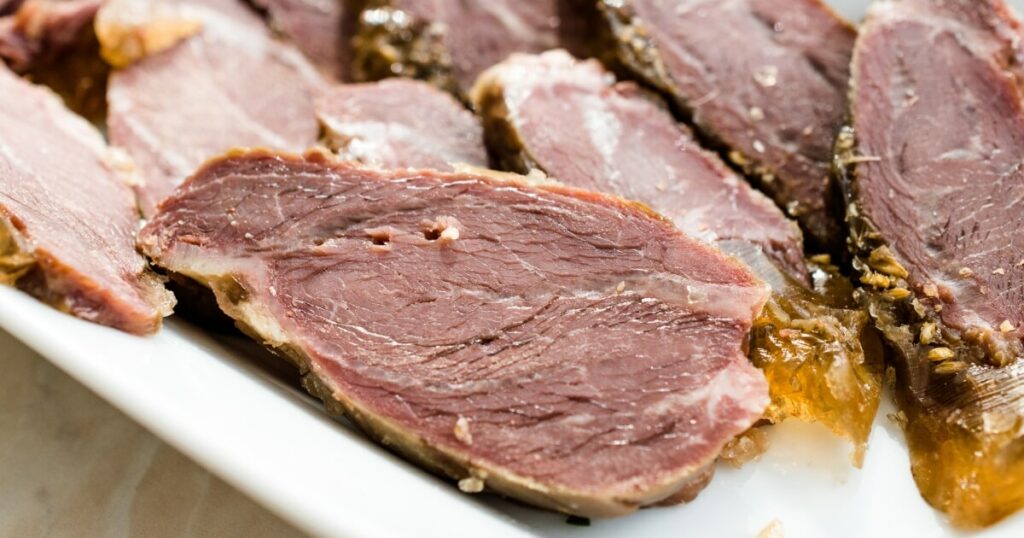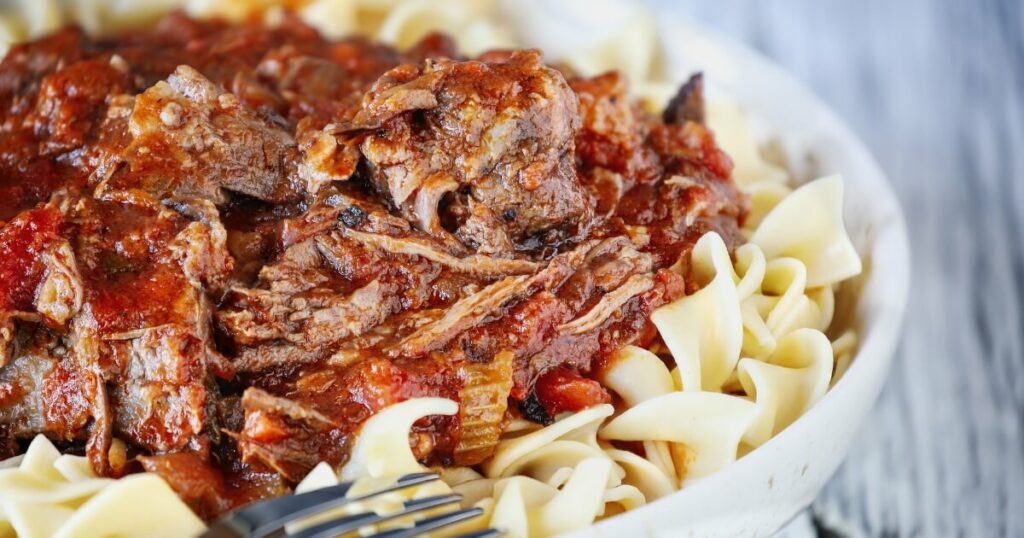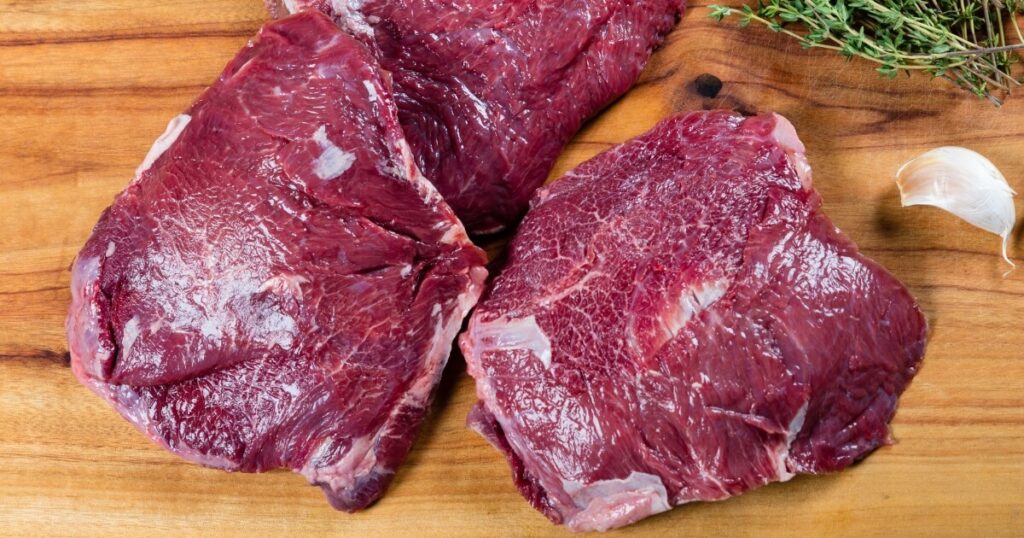Did you know that beef cheeks are one of the hardest-working muscles in a cow’s body?
That’s right! These little powerhouses are constantly at work, helping our bovine friends chew their cud all day long.
And it’s this constant workout that gives beef cheeks their incredible flavor and texture.
Now, I know what you’re thinking. “Beef cheeks? Are they really that good?”
As a home cook who’s always on the lookout for new flavors to bring to the table, I can tell you that they’re more than just good they’re incredibly delicious.
In this guide, we’ll explore the unique taste of beef cheeks, how to cook them, and why they’re a must-try if you can find them at your local butcher.
How Do Beef Cheeks Taste?
The taste of beef cheeks is deep, rich, and robust beefy. Thanks to the collagen that breaks down during slow cooking, they offer a melt-in-your-mouth texture.

Diving deeper into the taste of beef cheeks, you’ll find that they’re a cut above the rest. They have a deep, beefy flavor that’s more intense than other cuts.
This is due to the muscle’s constant use, which develops a rich taste and a dense, meaty texture.
When cooked slowly, the collagen in the cheeks breaks down, transforming into a tender, almost buttery delight that melts in your mouth.
The smell of beef cheeks as they cook is nothing short of mouthwatering. The scent is rich and meaty, with a hint of whatever delicious ingredients you’ve chosen to cook them with, be it a robust red wine, aromatic herbs, or a tangy barbeque sauce.
The taste of beef cheeks can vary depending on how they’re cooked.

When braised or slow-cooked, they become incredibly tender and captures the flavors of the cooking liquid, resulting in a rich, complex taste.
On the other hand, when smoked, they take on a smoky, charred flavor that adds an extra layer of depth to their natural beefiness.
What Does Beef Cheeks Compare With?
- Short Ribs: Just like beef cheeks, short ribs are rich in flavor and become incredibly tender when slow-cooked. They both share a deep, beefy taste that’s enhanced by slow cooking.
- Oxtail: Oxtail and beef cheeks have a similar texture thanks to their high collagen content. Both cuts become melt-in-your-mouth tender when cooked slowly and are packed with flavor.
- Pork Cheeks: While the flavor is different due to the type of meat, pork cheeks share the same tender texture as beef cheeks when slow-cooked. They both offer a rich, hearty taste that’s a delight to the palate.
- Brisket: Brisket, when slow-cooked, can have a similar texture to beef cheeks. Both cuts are known for absorbing the cooking liquid’s flavors, resulting in a complex, layered taste.
- Beef Shank: Beef shank and beef cheeks are both tough cuts of meat that become tender and flavorful when cooked slowly. They share a robust, meaty taste that’s a hit in hearty dishes.
Do Beef Cheeks Taste Good?
If you’re a fan of rich, beefy flavors and tender, melt-in-your-mouth textures, you’ll likely find beef cheeks absolutely delicious.
On the flip side, beef cheeks might not be for you if you’re not a fan of strong, meaty flavors or prefer your meat a bit on the firmer side.
Another thing to consider is that beef cheeks really shine when they’re cooked slowly, allowing the collagen to break down and the meat to become tender.
If they’re rushed or not cooked properly, they can end up being tough and chewy, which isn’t a great eating experience.
How To Make Beef Cheeks Taste Good
- Slow Cook: Beef cheeks are a tough cut of meat that benefit from slow, low-temperature cooking. This lets the collagen in the meat to break down, resulting in a tender, melt-in-your-mouth texture.
- Braise: Braising is a great method for cooking beef cheeks. This involves searing the meat first to lock in the flavors, then cooking it slowly in a small amount of liquid. This method enhances the beefy flavor and makes the meat incredibly tender.
- Use Aromatic Ingredients: Beef cheeks absorb the flavors of the ingredients they’re cooked with. Using aromatic ingredients like garlic, onions, herbs, and spices can add depth and complexity to the flavor of the meat.
- Choose the Right Liquid: The liquid you use to cook beef cheeks can greatly influence flavor. Red wine, beef broth, or even beer can add unique flavors to the meat.
- Season Well: Don’t forget to season your beef cheeks well before cooking. Salt and pepper are a must, but feel free to experiment with other spices to suit your taste.
How To Eat Beef Cheeks
Braised Beef Cheeks

One of the most popular ways to eat beef cheeks is to braise them. This involves searing the cheeks to lock in the flavors, then slow-cooking them in a flavorful liquid until they’re tender.
The result is a dish that’s rich, hearty, and packed with flavor. Braised beef cheeks can be served with mashed potatoes, polenta, or a side of vegetables for a complete meal.
Beef Cheek Tacos
If you’re a fan of Mexican cuisine, you might enjoy beef cheek tacos. The tender, flavorful meat is perfect for filling tacos and pairs well with traditional taco toppings like salsa, cilantro, and lime.
The robust flavor of the beef cheeks stands up well to the bold flavors of Mexican cuisine, making for a delicious and satisfying meal.
Beef Cheek Ragu

Another delicious way to eat beef cheeks is in a ragu. This involves slow-cooking the cheeks until they’re tender, then shredding the meat and simmering it in a rich tomato sauce.
The result is a hearty, flavorful ragu that’s perfect served over pasta or polenta.
Smoked Beef Cheeks
For those who love barbecue, smoked beef cheeks are a must-try. The cheeks are seasoned with a dry rub, then smoked slowly until tender and flavorful.
The smoky flavor adds an extra layer of depth to the already rich taste of the beef cheeks, making for a truly mouthwatering dish.
No matter how you choose to prepare and eat beef cheeks, one thing’s for sure: this underrated cut of meat is a culinary delight that’s sure to impress. So why not give it a try and see for yourself?
What Do Beef Cheeks Look Like?
Beef cheeks, as their name suggests, come from the facial muscle of the cow.
In their raw form, they’re quite a sight to behold. They’re typically a deep, rich red color, indicating the presence of myoglobin, a protein found in muscle tissue that turns red when exposed to oxygen.

The texture of raw beef cheeks is quite firm and a bit grainy, with a noticeable amount of connective tissue running through them.
Beef cheeks are relatively small compared to other cuts of beef. They’re usually oval or round in shape and typically about the size of an adult hand.
When cooked, they turn from a deep red to a rich, dark brown color. The texture changes as well, becoming incredibly tender and almost buttery, thanks to the collagen that breaks down during the cooking process.
One notable feature of beef cheeks is the layer of fat that often surrounds them. This fat can be trimmed before cooking, but leaving some on can add extra flavor and moisture to the meat as it cooks.
Beef Cheeks FAQs
What is the best way to cook beef cheeks?
The best way to cook beef cheeks is to braise or slow-cook them. This lets the collagen in the meat to break down, resulting in a tender, melt-in-your-mouth texture. Season the cheeks well, sear them to lock in the flavors, then cook them slowly in a flavorful liquid until they’re tender.
How long should beef cheeks be cooked?
Beef cheeks should be cooked for a long time to allow the collagen to break down and the meat to become tender. This usually takes around 3-4 hours when braising but can take up to 8 hours in a slow cooker. The key is to cook them low and slow.
Are beef cheeks a tough cut of meat?
Yes, beef cheeks are a tough cut of meat due to the amount of collagen and connective tissue they contain. However, when they’re cooked slowly, this collagen breaks down, and the cheeks become incredibly tender.
Can beef cheeks be smoked?
Absolutely! Beef cheeks can be smoked for a delicious, smoky flavor. You’ll need to cook them low and slow to allow the collagen to break down and the meat to become tender.
What dishes are beef cheeks commonly used in?
Beef cheeks are commonly used in braises, stews, and ragus and are also delicious when smoked. They can be used in tacos, pies, and even pasta dishes.
My Tasty Thoughts
One of the things I love about beef cheeks is their versatility.
Whether you’re braising them for a comforting winter meal, smoking them for a summer barbecue, or using them in a hearty ragu, they always deliver on flavor.
And let’s not forget beef cheek tacos, a personal favorite of mine!
If you’re new to beef cheeks, don’t be intimidated by their unfamiliarity. Remember, the best dishes often come from stepping out of our comfort zones. So go ahead, give beef cheeks a try. You might just discover your new favorite cut of meat.


